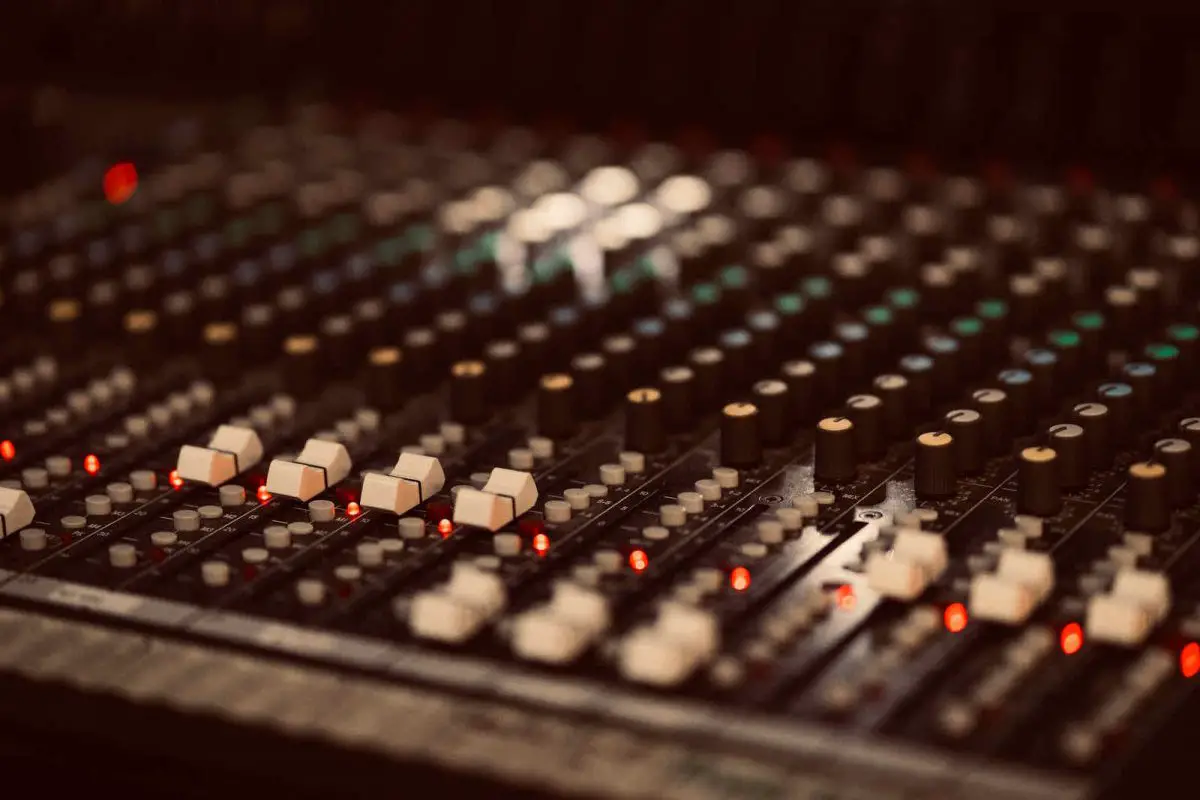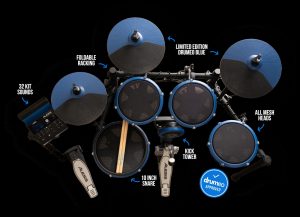Want to know if you can play live with electronic drums? Electronic drums might actually be used live more than you think. Here, we look at some of the reasons why you might want to use your electronic drums live, discover some of the possible downsides, and how to achieve an acoustic look to your electronic drum set.
Do professional drummers use electronic drums live?
There are many professional drummers who use electronic drums live. Famous examples include the late, great Neil Peart of Rush, who incorporated Roland drum and cymbal pads into his monstrous 360-degree drum kit when playing live. Another well-known drummer using electronic drums is Josh Dun of 21 Pilots, who uses a full electronic A-to-E converted drum kit when playing on the B stage at larger venues, alongside electronic pads on his main stage kit.
Contrary to what many drummers might think, electronic drums are used a surprisingly large amount on stage, whether incorporated into acoustic kits or in their own right. That makes sense when you consider modern music incorporates more electronic drums and samples, but what if you want people to think you’re performing on a ‘real’ drum kit?
Achieve an acoustic kit look with electronic drums
Many acoustic drummers turn up their noses at electronic drums, and part of the reason is aesthetics. Electronic drums of old looked nothing like ‘real’ drums, and that has a bearing on stage presence.
One genre where electronic drums are sometimes played live or for triggering samples is electronic dance music.
But since electronic drums are synonymous with this genre, they can look a bit odd when used for other acts, especially if the music has a more ‘acoustic’ sound. Audience members are not used to seeing electronic drums on stage, so when a piece of scaffolding with a few small pads takes up centre stage, it can look a bit odd.
Fortunately, that is starting to change, with the rise of the trend in acoustic to electronic (A to E) drum conversions, followed by the launch of eDrums that look like acoustic drums, such as the ATV aDrums, Roland VAD series, or EFnote drums.
Now, it’s possible to play live with an electronic drum kit that looks almost indistinguishable from an acoustic kit, where only audience members who are drummers themselves would likely spot the differences.
What are the benefits of playing live with electronic drums?
Greater control over volume
The main problem with acoustic drums is there is no volume control when you’re playing in smaller venues, it’s down to you as a drummer to control your own volume by playing gently.
Unfortunately, this doesn’t always work, especially if you’re a drummer who’ll naturally get louder as you get more energetic behind the kit. Plus, if you’re in a punk rock or metal band, playing gently doesn’t lend itself well to the music.
The big benefit of playing with electronic drums is there is full control over the volume, while you can go all out on the kit to bring the energy and stage presence to match the intensity of the music.
Gig in different venues and scenarios
A knock-on effect of being able to control the volume is you may open up new gigging opportunities. Some venues have strict noise levels to adhere to, and as mentioned, some genres don’t really work at lower volumes. But with this issue solved by gigging with an electronic drum kit, you may be able to perform at a wider range of venues without compromising the music.
This means if you’re a louder band you might be able to negotiate to play at smaller venues that might not usually be able to carry acts like yours or perform at functions that have a specific need for a band to play at a lower volume than usual.
Match the real song’s drum sound more closely
Finally, electronic drums can allow you to play with drum samples that more closely match the original recording of the songs you play.
Imagine you’re an 80s act and want to try and replicate the gated reverb snare sound that was synonymous with this era. If you’re playing a gig where you can’t mic up your drums, then that’s not really possible. But with electronic drums, you can simply load the sample on your module or via a VST and get the right snare sound with ease.
You could even switch between drum sounds between songs. Let’s say you’re trying to evoke an 80s sound in one song and a 90s sound in the next. Between songs, you can switch from that gated reverb snare to a piccolo snare. On an acoustic kit, you’d either need to compromise on the snare sound, or bring along extra drums, and be sure that the sound engineer is happy for you to switch mid-gig!
What are the downsides of playing live with electronic drums?
Reliability
The big upside of gigging with an acoustic kit is the simplicity. If a mic breaks, the drum still makes a sound, so at small venues, you can still play. With an electronic kit, there’s more that could go wrong, and if the module were to stop working, then that’s the end of the gig.
However, it’s important to note that this is very rare, especially if you buy a professional kit from a brand like Roland, Yamaha or ATV.
If you use your electronic drums to trigger drum samples (which you can read about in our guide on how to make your eDrums sound real), then you’re adding more complexity that could cause issues. If you’re running your drum library software off a laptop, then you’re contending with other possible issues, such as untimely software updates, other applications causing issues, or random crashes.
If you can, it’s a good idea to have a separate ‘gigging’ laptop that only contains the software you need for live shows, that’s not connected to the internet, and updates are only applied when necessary.
Are you considering Mac vs Windows? In the past, most creatives swore by the Mac, and they’re definitely still a common sight on stage and in the studio. Macs have a reputation for reliability going back many years, which is hugely important. Macs have a tighter integration of software and hardware which aids with reliability. Certainly in the 90s and 00s, PCs were well known to be less reliable, partly down to the huge breadth of different hardware that the software needed to work with.
Macs also had some quality of life improvements for musicians, too. Mac users never had to deal with intrusive antivirus software, and avoided annoying Windows issues such as unsolicited updates launching at the worst time, or security dialogue boxes that would pop up and lock the entire computer until it was dismissed.
These days though, the gap is much closer, and you’re likely to be just as happy with a Mac or a PC. Either way, for the best experience using a laptop to trigger VST drums live, do consider using a specific ‘gigging’ laptop.
Electronic kits might not suit all music
If already play a low-volume style of music, for example, if you’re a jazz drummer using brushes, then realistically you probably don’t need to use an electronic kit live, as you’re already at a suitable volume level.
But where eDrums could be good for playing live, is if you need to create a powerful, energetic sound at a lower volume, such as recreating an 80s power ballad snare sound. Dialling in these tones in your drum module or VST instrument can be a better solution than using effects on a miked-up acoustic snare since you’d need to hit the drum with a lot of force to get a full sound. If there’s a strict volume limit at the venue, then it can be difficult to get enough power to get the effect you need.
Needing a good Front-of-House PA system
Finally, it’s worth considering if your front-of-house PA system is up to the task. At a basic level, you’ll need to ensure your PA can support routing drums, vocals, and potentially even the bass and guitar amps through it.
But on top of that, you need to consider the frequency response. Drums use almost the whole frequency range, from shimmering high-pitched cymbals right down to the bass drum.
To ensure your drums sound great, you need to ensure your PA can support such a wide frequency response, and that usually means ensuring you have a subwoofer as part of your system. Without a subwoofer, your bass drum can disappear into the mix and lack the punchiness of a real drum kit.
How to amplify your electronic drums when playing live
The best way to amplify your eDrums when playing live is to send your drum’s outputs through to the mixer, and send those channels to the PA. Read more about amplifying your electronic drums with our guide on if you need to use a DI box for electronic drums, if you need an amp for electronic drums, or find out if you can use a guitar amp with electronic drums.




